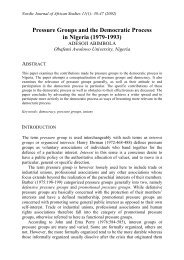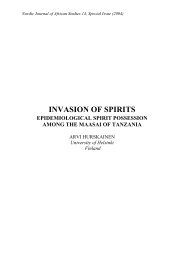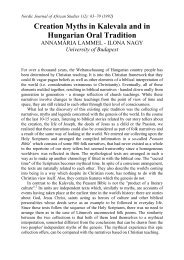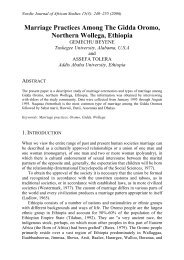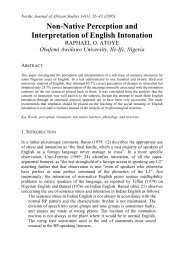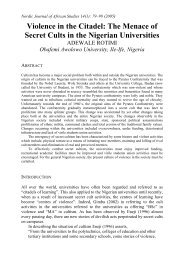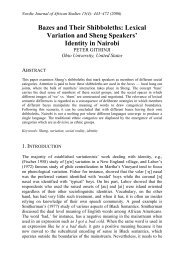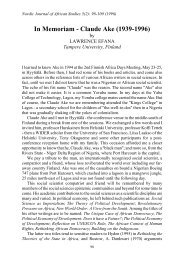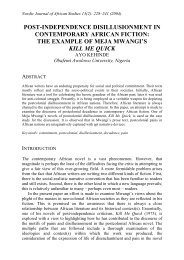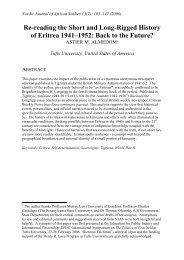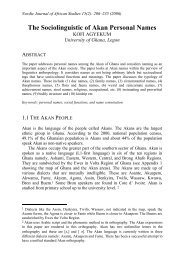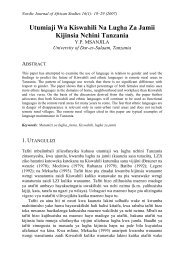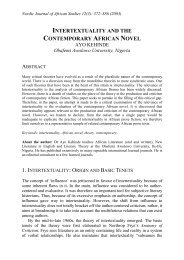Hottentot, Bushman, Kaffir: Taxonomic Tendencies in Nineteenth
Hottentot, Bushman, Kaffir: Taxonomic Tendencies in Nineteenth
Hottentot, Bushman, Kaffir: Taxonomic Tendencies in Nineteenth
You also want an ePaper? Increase the reach of your titles
YUMPU automatically turns print PDFs into web optimized ePapers that Google loves.
Nordic Journal of African Studies<br />
his suit, hav<strong>in</strong>g div<strong>in</strong>ed his true motive for approach<strong>in</strong>g her. Even the rudest<br />
barbarian, it was suggested, could see through the clumsy advances of the Duke of<br />
Clarence.<br />
The portrayal of Sartjee Baartman as a young woman f<strong>in</strong>ancially well-endowed<br />
and m<strong>in</strong>dful of the value of her assets may be <strong>in</strong>dicative of public awareness of her<br />
remarkable success <strong>in</strong> show bus<strong>in</strong>ess. Occasionally one f<strong>in</strong>ds <strong>in</strong> the press of that<br />
period waggish suggestions that she might now make an advantageous match for an<br />
ambitious suitor: "The damsel, it is said, has picked up some cash, and may become<br />
a desirable object <strong>in</strong> the eyes of some of our m<strong>in</strong>or fortune hunters." 11 The image of<br />
her as a female worthy of amorous attention was, of course, someth<strong>in</strong>g that the<br />
satirists cont<strong>in</strong>ued to exploit. But <strong>in</strong> Williams's caricature of the Duke of Clarence,<br />
the comic accent was on money rather than love. Any nobleman desperate enough<br />
to marry an African for f<strong>in</strong>ancial ga<strong>in</strong> clearly violated English norms of acceptable<br />
elite behavior. A duke's marriage with a <strong>Hottentot</strong> was unth<strong>in</strong>kable for it would be a<br />
betrayal of all the verities of race, class and gender.<br />
So the iconography of <strong>Hottentot</strong>s <strong>in</strong> early n<strong>in</strong>eteenth century England<br />
emphasized their biological <strong>in</strong>compatibility with Europeans. They were regarded<br />
not just as social and <strong>in</strong>tellectual <strong>in</strong>feriors but as a breed apart, a throwback to<br />
earlier evolutionary times, a rudimentary l<strong>in</strong>k <strong>in</strong> the great cha<strong>in</strong> of humanoid<br />
be<strong>in</strong>gs. And this closeness to nature, manifested <strong>in</strong> their strange anatomy and raw<br />
vitality, made them fasc<strong>in</strong>at<strong>in</strong>g and attractive to scientists, travellers, artists, and the<br />
ord<strong>in</strong>ary man on the street. They were the exotic, primitive Other aga<strong>in</strong>st whose<br />
arrested development one's own progress could be measured. The <strong>Hottentot</strong> Venus<br />
was therefore much more than a liv<strong>in</strong>g icon of sexual difference; she was Otherness<br />
personified - a s<strong>in</strong>g<strong>in</strong>g, danc<strong>in</strong>g, jiggl<strong>in</strong>g <strong>in</strong>carnation of one extreme <strong>in</strong> a rigidly<br />
hierarchical taxonomic paradigm. She gave body to racist theory.<br />
2. THE BOSJESMANS AND THE EARTHMEN<br />
The San who were exhibited <strong>in</strong> the British Isles were also assumed to be among the<br />
very dregs of humanity. The first troupe, consist<strong>in</strong>g of two men, two women and an<br />
<strong>in</strong>fant, arrived <strong>in</strong> 1846, shortly after P.T. Barnum's Tom Thumb had stormed<br />
Europe, populariz<strong>in</strong>g the display of unusual small people. 12 In newspaper<br />
11 Daniel Lysons, Collectanea; or a Collection of Advertisements and Paragraphs from the<br />
Newspapers, Relat<strong>in</strong>g to Various Subjects, Vol. 2. This unpublished scrapbook is available only<br />
at the British Library (1881.b.6).<br />
12 Tom Thumb's first European tour had started <strong>in</strong> London <strong>in</strong> 1844. At the end of the summer of<br />
1845 two "Bushmen Children" had been exhibited <strong>in</strong> London for a short time, but they do not<br />
appear to have made much of an impact and vanished quickly from the stage; a sketch of them<br />
was published <strong>in</strong> the Illustrated London News, September 6th 1845, p. 160. The Bosjesmans, on<br />
the other hand, rema<strong>in</strong>ed on tour for several years and were a very popular attraction. There is<br />
evidence to suggest that they were abandoned <strong>in</strong> Rouen by an unscrupulous manager <strong>in</strong><br />
December 1853 (see Goblot 1983: 40).<br />
10



